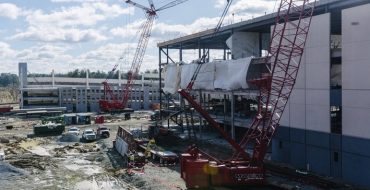
A jobsite practice that originated years ago to help contractors save time and money has been transformed into a necessity during the COVID-19 pandemic. Initially, videoconferencing was useful because it allowed stakeholders who might be states away to avoid purchasing a plane ticket or driving long distances to check on a site in person.
As the coronavirus outbreak reached the U.S. earlier this spring and businesses shut down, few employees could travel. In addition, social distancing protocols mean that only a handful of workers can be in one area of a jobsite at a time. But with videoconferencing, employees who work onsite can use their phones to get a progress check from a distance instead of crowding around an inspection point.
Clark Construction is one firm that has placed more emphasis on using virtual meetings to have teams and stakeholders inspect jobsites, although the practice existed before the pandemic.
Using simple online portals such as Zoom or Google Hangouts, the Bethesda, Maryland-based contractor can have a smaller number of stakeholders present on the site, giving a remote tour to 20 to 30 others in a different location, said Clark Vice President Jesse Wadeson.
While recordings or photos of jobsite work are sometimes used for out-of-town employees, they don’t provide stakeholders with the real-time ability to point out issues or discuss solutions. Video calls keep everyone on the same page and save time on RFIs or following up on different questions and problems, Wadeson said.
Few challenges
The good news is there are only a handful of roadblocks to implementing this practice. The biggest challenges are selecting a videoconferencing platform and ensuring service is strong enough to share clear video with the highest number of people. One of the ways Clark mitigated this was deploying cellular repeater stations onsite to boost the signal.
At a recent project in Columbia, Maryland, the Clark team used videoconferencing during a sealant test that required participation from stakeholders, while also limiting the number of people onsite, according to a Clark blog post. The test was live streamed to trade representatives, who could view the results, and recorded for future reference.
Wadeson said he wasn’t sure why this wasn’t more pervasive before the pandemic, but he anticipates a change once the crisis ends.
“I think people are more used to videoconferencing, and that is going to help people feel more comfortable with joining virtual meetings,” he told Construction Dive. “COVID has essentially forced it to happen. This is the new reality.”
In the future, inspections from state and local agencies may even turn virtual. In April, officials from the International Code Council discussed the benefits of virtual inspections during the pandemic, and advised that before inspectors make the move to virtual inspections to run it up the flagpole with each governing authority as a viable option.
George Mastakas, vice president of enterprise solutions at Cityworks, a Trimble company, told Construction Dive that he is optimistic the pandemic will lead to a more streamlined process.
“While we don’t see a complete shift off of sending a human, we are seeing a trend into trying to find better ways of serving contractors on the front end,” he said.